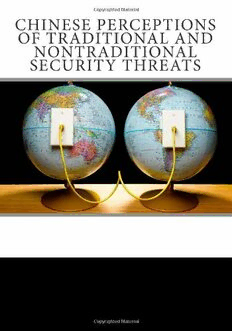
Chinese Perceptions of Traditional and Nontraditional Security Threats PDF
172 Pages·2007·0.642 MB·English
Most books are stored in the elastic cloud where traffic is expensive. For this reason, we have a limit on daily download.
Preview Chinese Perceptions of Traditional and Nontraditional Security Threats
Description:
In order to begin to understand the motivations and decisions of China’s leadership, and in order to behave in a manner such that we can influence them, we must try to understand the world as China does. This research is an attempt to do so by examining the writings and opinions of China’s scholars, journalists, and leaders—its influential elite. It will show that China has a comprehensive concept of national security that includes not only defending its sovereignty and territorial integrity, but continuing its economic and social development and maintaining its international stature. There are two main types of threats to China’s national security: traditional and nontraditional. Traditional threats can be characterized loosely as threats to a nation emanating from other nations and involving a military component. While the most talkedabout threat to China’s territory is a declaration of independence by Taiwan, the influential elite actually find this possibility unlikely. The focus is therefore on the few countries considered both capable of and willing to endanger all three of China’s components of national security: sovereignty, economic development, and international stature. The United States, Japan, and India have significant ideological, historical, or territorial disagreements with China and possess the military, economic, and/or international diplomatic means to go to battle over such differences. While China’s influential elite are concerned about a direct military confrontation with the United States, Japan, and India, they are far more concerned about the possibility of containment efforts by any—or all—of these countries. The threat of containment, however, is less of a military threat and more of a diplomatic, political, and economic one. The influential elite also express concern over the fluctuating, unpredictable, and seemingly unstable nature of the democratic process in all of these countries. Even more troublesome to China’s security environment are nontraditional threats. While military deterrence and diplomatic skill have managed traditional threats successfully to date, they are insufficient for overcoming nontraditional threats. Such threats, while never precisely defined by the influential elite, are considered to transcend national boundaries, go beyond the military sphere, are unpredictable and/ or unexpected, have both internal and external elements and ramifications, and are frequently interwoven with traditional security threats. There is an array of nontraditional threats facing China: bird flu, terrorism, proliferation, drug trafficking, AIDS, and piracy, to name a few. The focus of this monograph is on three nontraditional threats: economic and social disparities within China, environmental degradation, and energy insecurity.
See more
The list of books you might like
Most books are stored in the elastic cloud where traffic is expensive. For this reason, we have a limit on daily download.
